|
We are told that Monet used to get up at 5 o'clock in
the morning, look at the sky and, if he liked it paint, and if not,
go back to bed. How do you start your day?
I also get up at 5 o'clock but I have breakfast, then I look
at the sky and then I start painting regardless of the weather.
If it's terrible then I'll work in the studio on things that I've
started earlier but otherwise I head out on my bike.
Tell me about this bike. We've known each other for
forty years but I've never really understood how you cycle about
with wet paintings. Can you carry stuff like that Westminster Bridge
picture on it?
Yes, that one's 3 feet by 4 feet so it's about the largest I
can take. I also take a palette with two-inch panel pins around
the edge, and I place the wet side of the painting against the
pins and hold them both together with elastic so that the wet
paint is on the inside and protected. It's all rather primitive
but I've been doing it for years and it seems to work.
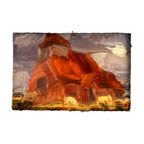 And
you must also carry large tins of paint? And
you must also carry large tins of paint?
I always take a five-litre tin of Stokes titanium white, two
and a half of bright red, two and a half of chrome lemon and the
same of Spectrum ultra marine.
That's twelve and a half litres of paint! And just three
primaries, that's it?
Yes. I mix it on the palette and although I used brushes for
many years, now I only use spatulas, and my fingers of course.
And how many hours would you work on a painting in this
way, and if it rains what do you do, do you stop?
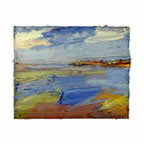 Each
day varies. It can be a few hours or the length of the light of
the day. Some paintings will literally start as a dawn painting
and end up as a dusk painting and it's only really foul weather
that stops me. It's the changes in the weather and the light that
sustain the spontaneity in the work so I try to keep going. In
high wind I use my bike to weigh down the easel and rain generally
just runs off rather than getting into the paint. Each
day varies. It can be a few hours or the length of the light of
the day. Some paintings will literally start as a dawn painting
and end up as a dusk painting and it's only really foul weather
that stops me. It's the changes in the weather and the light that
sustain the spontaneity in the work so I try to keep going. In
high wind I use my bike to weigh down the easel and rain generally
just runs off rather than getting into the paint.
I don't know of any other painter who paints London's
river as assiduously as you, and certainly not the way you do. To
me it's London's heartbeat but are you able to say what it is that
makes you choose the subject? Place is clearly tremendously important
so I suppose the question is: whether you live where you paint or
paint where you live, or is it both?
It's hard to think of a place that I didn't find
beautiful in one way or another, but cycling everywhere does set
limits. I moved to Rotherhithe twenty odd years ago looking for
cheap accommodation, so in a sense I luckilyended up living in
the place that I realised I wanted to paint. I'm surrounded by
the river's mythologies, its smells, its decay and regeneration
so I've had this endlessly fascinating subject quite literally
on my doorstep. The constant activity, the changing light, the
reflections of the sky and the mirroring, it's a double image
all the time and it seems you always have another chance to be
dragged along by it.
Above all your work is about light. You've said your
spontaneity is sustained by following the changing light and weather.
Do you follow these strictly through the day?
 Not
always, sometimes I freeze it at a certain point but still carry
on working although the light is changing. It's an endlessly flexible
process; it has to be because everything is constantly shifting.
The weather also has a say because I can be working on a marvellously
sunny day only to find that it's raining the next, so I'll either
work on it inside or start a rainy one, or a foggy one, or whatever. Not
always, sometimes I freeze it at a certain point but still carry
on working although the light is changing. It's an endlessly flexible
process; it has to be because everything is constantly shifting.
The weather also has a say because I can be working on a marvellously
sunny day only to find that it's raining the next, so I'll either
work on it inside or start a rainy one, or a foggy one, or whatever.
Do you have more than one version of a thing going according
to the weather then?
 Yes.
In this show there will be half a dozen pictures that are basically
the same subject but each is completely different. They become
other subjects in other conditions. The way the tide reveals and
hides things and completely changes the space is also fundamental
and is invariably a part of the title. Yes.
In this show there will be half a dozen pictures that are basically
the same subject but each is completely different. They become
other subjects in other conditions. The way the tide reveals and
hides things and completely changes the space is also fundamental
and is invariably a part of the title.
I can't help but notice though that you only paint from
the south side. From the north it is a very different landscape.
Occasionally I paint from the north bank but the south is generally
less impressive visually. Often I paint the view looking along
the 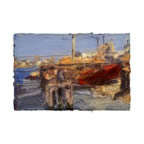 south
bank, but sadly I've lost a number of these sites because the
edge of the river is becoming inaccessible. Nosey people are a
problem and the nooks and crannies that I like to work in are
also attractive to some unsavoury characters and it can be dangerous,
so the choice of location has become a very practical matter.
At the moment I'm being driven down-stream and have been painting
at Greenwich. south
bank, but sadly I've lost a number of these sites because the
edge of the river is becoming inaccessible. Nosey people are a
problem and the nooks and crannies that I like to work in are
also attractive to some unsavoury characters and it can be dangerous,
so the choice of location has become a very practical matter.
At the moment I'm being driven down-stream and have been painting
at Greenwich.
The place you settle on might be a practical matter,
but not the subject. I wouldn't call that practical because you
take in all of the activity that's going on in front of you: the
boats that go past, people, wildlife, all manner of things that
probably only give you a second or two to react to. To what extent
would you say your response is instinctive or is intellectual?
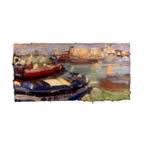 I
would say that the practical business of painting is largely instinctive
for me. I'm sure that all sorts of other things play a part: what
I've read, music, other painters or whatever, but not consciously
because I work so quickly, trying to catch each moment, each activity
of a constantly changing scene. I
would say that the practical business of painting is largely instinctive
for me. I'm sure that all sorts of other things play a part: what
I've read, music, other painters or whatever, but not consciously
because I work so quickly, trying to catch each moment, each activity
of a constantly changing scene.
Once the day is finished presumably you take the painting
home, and then the next morning you take a fresh look to see if
it's OK. What do you do if it's not, do you scrape them down?
Sometimes I take paint off but usually I try to hang on to things
and just work on.
When you rework something in the studio, do you become
a different person? Are you more conscious of composition so that
you start fiddling about with things and rearranging them?
I don't know about re-arranging, I would say it's an attempt
to re-emphasise.
You might not re-arrange the composition by moving objects
about, I didn't so much mean that, rather that you might alter tonal
values - which is actually not such a different thing. Suppose,
for example, you were to make bits darker or lighter, or change
their colour, this would in effect re-arrange the composition.
My paintings are really layers of experience. There are things
that you are conscious of experiencing and there are other things
that slip in all the time; things that occur almost by accident
that can either be wonderful discoveries or something that's wrong
and I allow myself to do whatever I think is right to resolve
the painting.
I would see London and the Thames as your main focus
but you also have Kent. This is your other big subject isn't it,
so do you have a place down there, a studio that you go to?
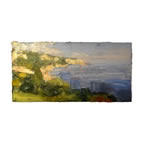 I
have a studio at Walmer, just along the coast from Deal, and have
been painting around there for thirty odd years. It's Turner territory
of course so it's incredibly daunting, but he seems to have painted
everywhere. I
have a studio at Walmer, just along the coast from Deal, and have
been painting around there for thirty odd years. It's Turner territory
of course so it's incredibly daunting, but he seems to have painted
everywhere.
It does appear to be like that. He refutes rather beautifully
the fashionable doctrine that your subject matter should be your
immediate surroundings, but I always think of you as a present day
Barbizon painter setting out in the morning looking for what is
called 'the motif'. Clearly place is important but your attraction
to natural history also interests me because, although your subject
may dictate the drawing and the colour, the handling of the paint
in the Kent landscapes shows a love of geology and a love of growth.
That is very much how I think when I'm working there. It's a
very organic process and I sometimes feel that the paintings haven't
remained free enough and, although I shouldn't be saying this,
they can feel stilted compared to the actual thing that's out
there in front of me.
You make it sound a bit Flaubertian 'Every morning I
rise to conquer the world but every evening I retire defeated'.
It isn't as bad as that is it?
Both probably marginally less !.
You've settled on Deal and the Thames which is almost
all of your total outdoor subject matter. Did you go through other
parts of the country before you got to either of these.
Not really. I was born in Scotland but grew up in Lincolnshire
and then went to Grimsby Art School and, like lots of youngsters
from the provinces, first experienced great paintings from library
books, van Gogh's paintings I remember touched an early nerve.
They looked real in a way that other paintings that I was looking
at in books didn't. I suppose the rhythm of the Wolds approximated
to the rhythms in his paintings so that they seemed like life
as I had experienced it and that certainly stimulated very early
on the idea of going out to draw and paint.
Did you read the letters?
Yes. Peter Todd, a wonderful man who was principal of the art
school in Grimsby lent me all three volumes. I went through them
solidly and still go back from time to time. They are an endless
inspiration actually.
They are wonderful. They are some of the most inspiring
documents an artist can ever get his hands on.
And they endlessly teach me that there can be no reason not to
work.
You seem to have done a hell of a lot by most people's
standards, but you don't seem to have to drive yourself to paint,
you just seem to want to do it. Were there other British artists
that influenced you when you were young?
Yes, there's a thread that runs through all the painters that
I love but the painters that really inspire me aren't always the
greatest painters, but they are painters that I love because they
bring this quality of living paint. Soutine had it and I don't
think he was one of the greatest artists. 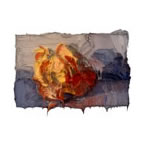
I would say that your early painting was much more tortured
and less to do with light, and that the evolution has been really
rather delightful from my point of view. Does this just reflect
the way that your mind has worked or is it actually a reflection
of your life?
I think it's both. I'm now more reflective about life but that's
because my life's been changed through this activity of painting.
I feel privileged to be involved with it, and because of that
I'm a much more settled person. I feel more a part of the world.
Your paintings are also more part of the world. They've
moved towards a sort of joyous appreciation of life, of light filled
life. Your approach may have become simpler, but what the paintings
convey has become much more complicated because you've introduced
a subtlety of observation which, if you'll forgive me for saying,
was less developed all those years ago.
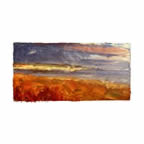 I
do feel myself that I'm now more open to fact and to experience,
more innocent I suppose. The excitement of chance encounters is
now much more thrilling than trying to fulfil some sort of propaganda.
I find that the fall of light from the sky is just one of the
most glorious things. A daily gift. I
do feel myself that I'm now more open to fact and to experience,
more innocent I suppose. The excitement of chance encounters is
now much more thrilling than trying to fulfil some sort of propaganda.
I find that the fall of light from the sky is just one of the
most glorious things. A daily gift.
This conversation was recorded at
the artist's studio in December 2004 and subsequently edited by
Michael Richardson.
View the Exhibition
|